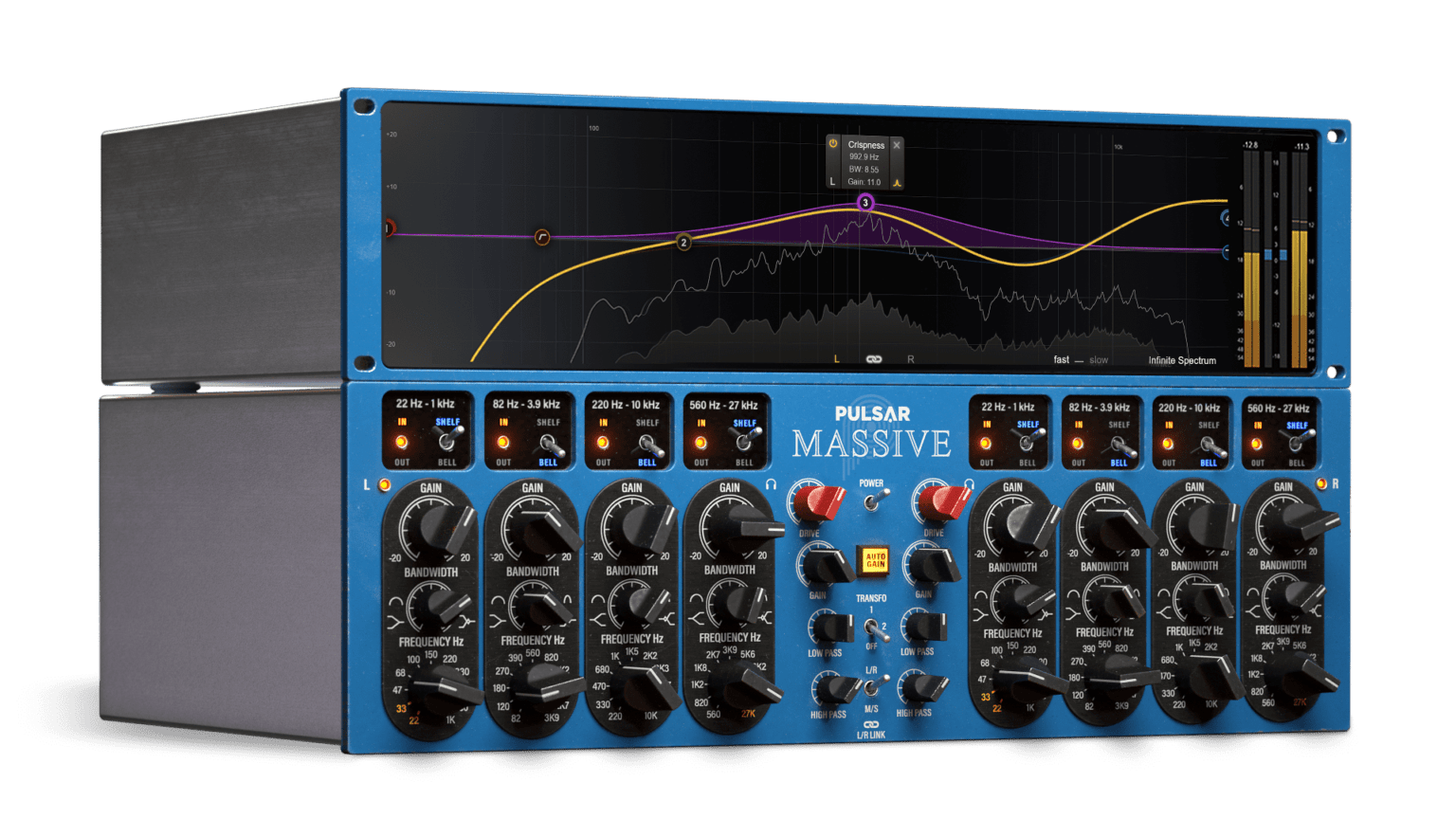



The most complete passive EQ plugin. Musical and intuitive, a must-have for mixing and mastering.
A DIFFERENT EQUALIZING EXPERIENCE
Pulsar Massive is an emulation of a legendary analog EQ that is present in almost every mastering studio in the world. This machine was designed as a synthesis of the best passive equalizers of the last 70 years, and several distinct features in the design give it an absolutely unique sound.
First of all, the fully parallel topology of the EQ gives completely different kind of response to a digital equalizer with the same settings. A parallel equalizer’s tonal corrections aren’t cumulative, but tend to interact with each other, resulting in a more intuitive and fluid way to shape the frequency spectrum.
As well as this, the whole equalization circuit of the original hardware is passive, and therefore has several inductors. These inductors, machined and wound specifically by the manufacturer, are responsible for a creamy, non-linear and organic sound due to the magnetic saturation they introduce.
Finally, the input, output, and internal gain stages are entirely tube and transformer operated, providing another step of warm and organic coloration.
Our software meticulously reproduces all these important aspects of the original hardware, but also offers an interface inspired by its ergonomics, which were much appreciated by its users.
But we’ve taken Pulsar Massive even further, adding all the key features you would expect from a modern, versatile EQ plugin, including visual curve editing for a fast workflow and a drive parameter to push the inductor and tube saturation stages harder for more vibe.
MASTERING BUNDLE
MASSIVE & MU
Two plugins designed to work together and to become
the ultimate musical mastering chain.


Improving on a classic
Pulsar Massive comes with a complete on-screen curve editor and spectrum analyzer. This best-of-both-world approach gives an accurate overview of your EQ changes while highlighting the singular behaviors of the original unit. The easy-to-use graphic interface allows a fast and radical workflow for mixing applications.
The Drive control allows usage of the plugin at internal levels where the analog vibe of the original unit is unusual and musical. Pulsar Massive’s accurate models of transformers, tubes, and inductors produce large amounts of harmonics and non-linearities. All coupled together, these are responsible for the subtle, dynamic and program-dependent low-end compression beloved by generations of sound engineers.
Pulsar Massive is a component-accurate model of the original unit, perfectly emulating its parallel EQ design and the unique sound-sculpting feeling. With parallel EQ, band gains don’t accumulate as in most other EQs, but rather recombine to produce natural-sounding corrections. The Pultec-like low-shelf filters allow a generous and tight low end, even at extreme boost settings. The high-shelf filters provide a pristine top end and air without harshness.
Listen for yourself
How does it sound?

Smooth and musical
Just ask any experienced engineer to hear a ringing endorsement of passive EQ and its uses! Pulsar Massive’s sound can be described as giving a creamy top-end, well-balanced mids, and a punchy low-end. Whether you’re using subtle or extreme settings, audio never sounds over-equalized, but rather vivid and natural, keeping true to the nature of your source material.
For mastering
In mastering, Pulsar Massive is the perfect tool to add sparkle and heft to your mix. For instance, it’s often used to add power to the low end (47 or 68 Hz) while retaining dynamic separation and balance between kick and bass, or to add air (16 kHz high-shelf) without any harshness. Pulsar Massive is also mind-blowing when used in Mid/Side mode, for perfect control over the stereo scene.
On vocals
A creative and musical tool for lead vocals, Pulsar Massive is excellent for adding presence (with the 3.3kHz or 4.7kHz bell filters), and some low-mid warmth without any mud (with the 220Hz low-shelf for instance), thanks to the Bandwidth parameter. The 1.6kHz bell filter is magic to add or remove density, helping a vocal to sit in the mix. Don’t hesitate to really push the drive for some creamy saturation!
Mixing electric guitar
Saturated electric guitars are very busy in the midrange – especially in extreme musical styles, and this can make them difficult to mix. Because the human ear is very sensitive to spectrum and phase manipulation in these areas, Pulsar Massive, with its smooth parallel EQ curves and naturally gentler phase alteration, is the perfect tool for shaping tone without messing with the phase.
Working the drum bus
Whether it’s used for cleaning mud (a gentle bell cut at 180Hz), to tame harshness on overheads (a gentle bell cut at 2.2kHz), or to add brilliance (a gentle high-shelf boost at 8.2kHz), Pulsar Massive will bring a coat of polish to push your drums to the next level. To top it off, you can adjust how Pulsar Massive reacts to the transients of the kick and snare with the Drive control, for a customized dynamic response.
Electronic music
Pulsar Massive can be used as a sculpting tool for very rich sources like synth pads or synth basses. Use it in creative ways, experimenting with extreme curves and driving it hard – you won’t have to work hard to get great results. In addition, on a mixbus, choosing the right transformer will allow you to beef up your kick drum or keep it tight.
Featured videos
Pulsar Massive Walkthrough
The beauty of Massive bottom
5Ways To Use Pulsar Massive
FEATURES
SYSTEM REQUIREMENTS
DOWNLOADS
FEATURES
Main Features

Modern EQ Edition
For the first time, a plugin enables you to manipulate a very peculiar analog-shaped EQ curve in an intuitive way. The curve editor is extremely easy to use, with a clear and concise overall frequency response display. You can edit all properties of any filter – including its assigned name – without touching the lower panel.

Drive control
This parameter helps you increase or even decrease the distinctive and musical analog vibe of the original unit. Accurate models of transformers, tubes, and inductors are all coupled together to reproduce the program-dependent subtle low end compression beloved by generations of sound engineers.

Mid-Side processing
Pulsar Massive comes with built-in optional M/S encoding and decoding, enabling a signal’s mono and stereo information to be processed separately with different settings. The Listen buttons help audition each signal in isolation, and the screen displays only the channel you’re working on, so you always know what you’re doing.

Auto-gain
This control compensates for volume changes introduced by equalization, keeping output level consistent with input. It uses a C-Weighting-based algorithm to introduce a level compensation based on EQ curve analysis. The compensation gain applied only depends on your EQ settings and won’t change during playback.

Metering & Spectrum analyser
The on-screen analyzer displays the audio spectrum in real-time (fast and slow window settings) or over the long-term with the Infinite Spectrum setting. In addition, peak metering provides insight into overall dynamics, and RMS meters let you monitor loudness and level matching. An overall gain meter is also available.

Transformer
Choose between three output transformer options: An “original” mode that is true to the performance of the hardware’s circuitry; an exclusive setting even more colorful than the original, allowing warm low-end coloration; and an option to remove output transformer modeling altogether.

Oversampling
Pulsar Massive takes full advantage of modern CPUs to do more with less. A selectable oversampling mode is also available for computers that can handle it, with processing at rates up to 384 kHz. You can choose for higher oversampling settings to be applied at export than at playback.

Smart GUI
Pulsar Massive comes all wrapped up in a responsive and resizable interface. A resize handle enables you to choose the perfect size for each use case, from nice and compact to highly visible.
SYSTEM REQUIREMENTS
System Requirements
CPU
- Intel Core i3 / i5 / i7 / i9 / Xeon or AMD Quad-Core minimum
Memory
- 4 GB RAM
- 1 GB free disk space
Operating System
- Windows 7 with SP1 64 bit
- Windows 8.1 64 bit
- Windows 10 64 bit
GPU
- OpengGL 2.0 compatible GPU
Monitor
- Resolution: minimum 1024x768, recommended 1920x1080
- Refresh rate: 60 Hz
CPU
- Intel Core i3 / i5 / i7 / Xeon / Apple Silicon (M1, M2, M3, M4)
Memory
- 4 GB RAM
- 1 GB free disk space
Operating System
- MacOS 10.11 or later
GPU
- OpengGL 2.0 compatible GPU
Monitor
- Resolution: minimum 1024x768, recommended 1920x1080
- Refresh rate: 60 Hz
Compatible plugin formats

AAX Native
Windows: 64 bits only
Mac: 64 bits only

Audio Unit
64 bits only

VST 2.4
Windows: 64 bits only
Mac: 64 bits only

VST 3
Windows: 64 bits only
Mac: 64 bits only
DOWNLOADS
Downloads
Our software is protected with PACE Anti-Piracy, so you will need an iLok account to use it. On Windows, our installers will automatically install the iLok License Manager on your computer. You can find additional information and support on the PACE iLok website.

Andrea Lepori
Producer | Mixing Engineer
U2 | The Rolling Stones | Jack Savoretti
“Pulsar Massive gives a whole new and more modern appeal to the sound even when used in the more ‘traditional’ boost/cut way – that made the original unit so unique, but it also adds the flexibility of actually sculpting sounds to their core in a super musical way that is, to me, unmatchable by any other of this kind“
John Nathaniel
Producer | Composer | Mixer
OneRepublic | Gwen Stefani | Madison Beer | Kygo
“This eq is incredibly cool! It gives you the vibe and sonics of an analog EQ, but you can also control it like a modern slick digital EQ, taking full advantage of the digital power!”

FREE Full-feature 14-day trial
These installers set up the complete plugin version and allow to start a full-featured 14-day trial period.
Massive and Mu software are neither approved nor endorsed by the original hardware manufacturer, and bear no affiliation with the eminent products they seek to emulate.
The name Massive alone is a registered trademark of Massive Audio Inc.
Massive is also the name of a virtual synthesizer plug-in released in 2007 by Native Instruments GmbH, with which we are not connected in any way.







